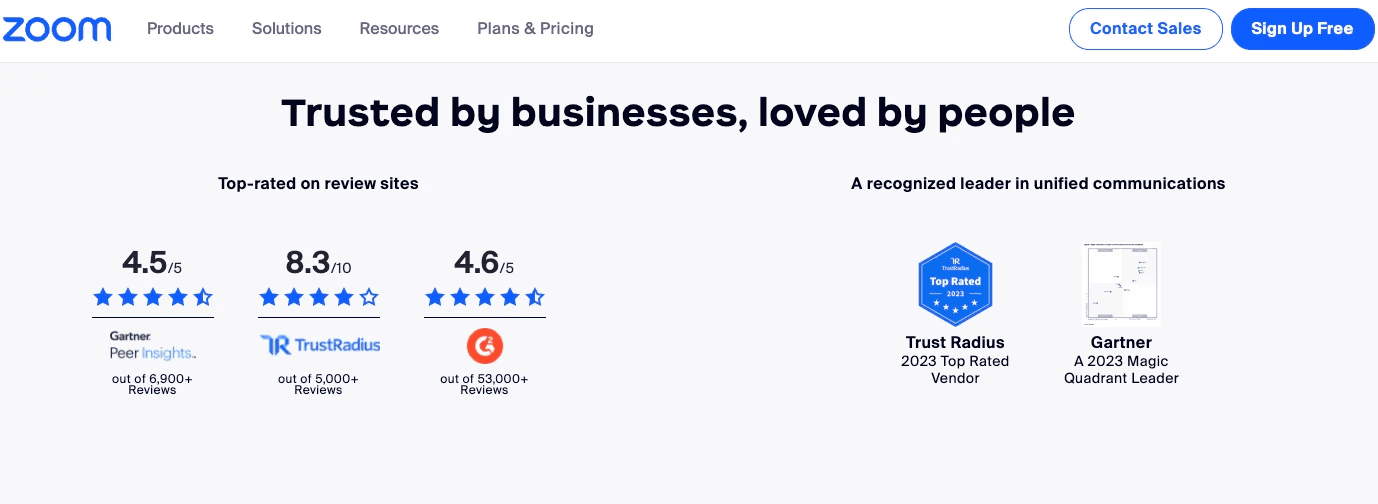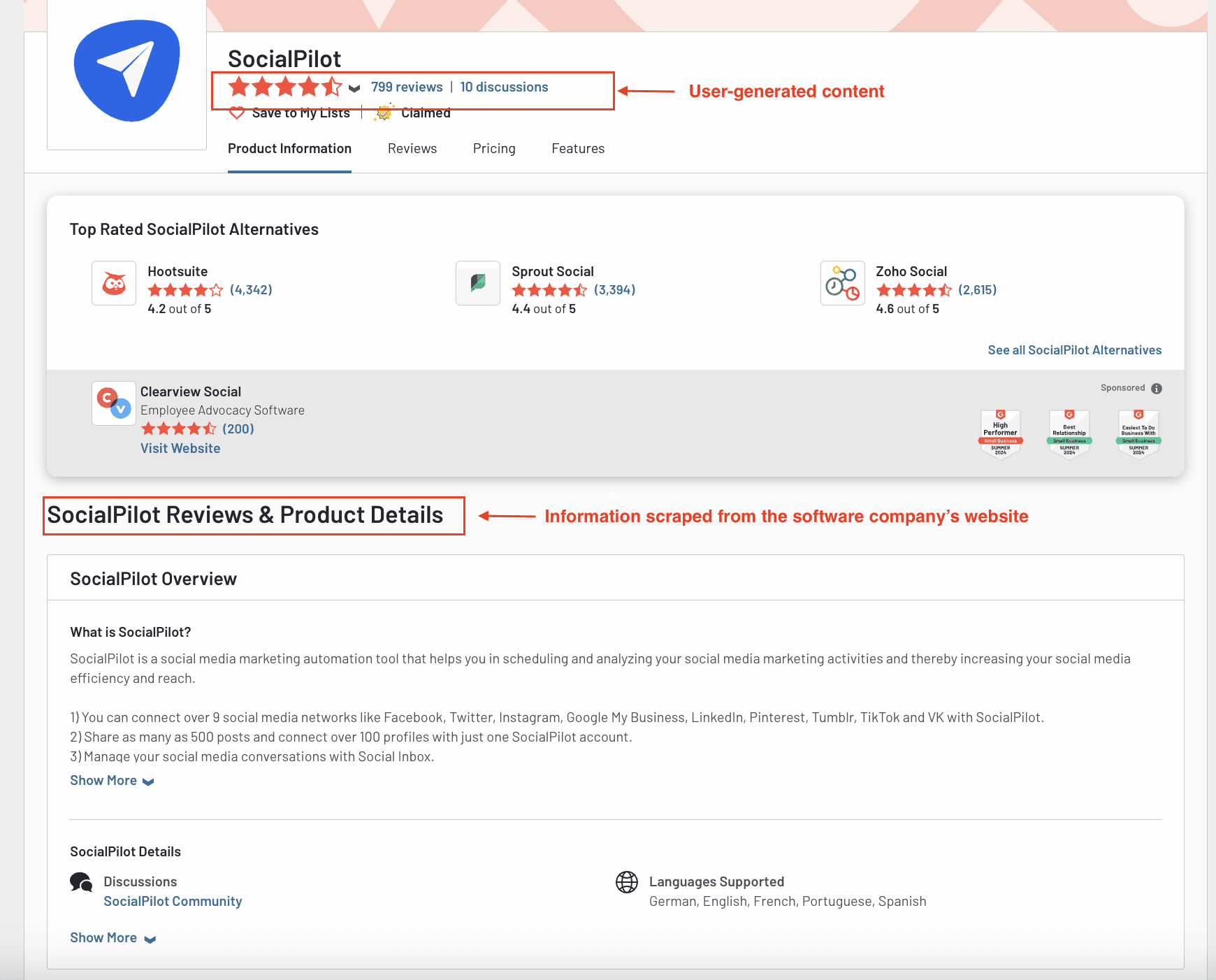pSEO handbook: how to leverage user-generated content to fuel your pSEO strategy
Programmatic SEO allows you to create thousands of highly targeted pages at scale, while user-generated content (UGC) brings real-world relevance and authenticity to your brand. By merging these strategies, you can create a self-sustaining ecosystem of valuable, search-optimized content that resonates with search engines and users.
Examples of UGC pSEO strategies
Pinterest is a prime example of UGC-driven pSEO. The entire platform is built around users creating “Pins” that act as templated pSEO pages. Each Pin contains the same search-optimized elements, so every Pin page has an identical structure, regardless of the user who posted it. By allowing users to create highly specific Pins (e.g., “Sunset yoga on beach photo” or “Cute dog with wildflowers”), Pinterest can target long-tail keywords and capture niche search traffic.
G2 is another example of UGC-driven pSEO. G2 generates thousands of product review pages that drive more than 1.2 million monthly organic visits (per Ahrefs data). While users don’t create G2’s product review pages, they do provide the content (product reviews and ratings) that fuels them.

Why is UGC a natural fit for pSEO?
UGC is a goldmine for pSEO because it nearly eliminates the guesswork in identifying and building a longtail keyword strategy (i.e., the foundation of a pSEO strategy). Rather than staying on top of longtail keyword trends, you can rely on your users to create content related to keywords that perfectly align with your target audience’s challenges, needs, and wants.
For example, Airtable, a low-code solution for building and sharing databases, found that its users were leveraging its product in ways they never intended. This insight led to the development of “Airtable Universe,” where users could upload their own Airtable creations/templates to a library and share them with others. Now, Airtable Universe houses over 1,000 pages generated by users. These pages capture a variety of long-tail keywords for niche topics like “coffee distribution sales template.”
High-quality UGC also naturally attracts backlinks from people and companies who want to either:
Share their creations with their social networks (e.g., Pinterest users share Pins and Boards on their blogs.)
Showcase trusted third-party reviews to validate the value of their products/features (e.g., Zoom links back to user-generated review pages on the G2 site to validate its status as a “best-in-class” video conferencing platform.)

Steps to build a pSEO engine with UGC
Step one: Identify product-related content opportunities
Start by asking yourself these two questions:
“What specific features or aspects of our products do people consistently share with others?”
“What are ways people already engage with our product or brand that could be turned into content?”
These questions will help you identify how your users naturally share and engage with your products/features. This will reduce the legwork required to garner user participation and the time required to see the content strategy scale to hundreds or thousands of pages.
To answer these questions, you can engage social listening tools like Hootesuite or Brandwatch, conduct user interviews, or make general hypotheses based on the features within your platform that get the most use.
For example, AI music generation startup soundraw.io has garnered over 557,000 users since launching in 2020. Its base of content creators and artists uses Soundraw’s tools to generate royalty-free background music for their projects and songs. Creators can choose the length, mood, genre, theme, and tempo and then fine-tune the AI-generated song at different intervals.
By giving artists and creators a space to share their background music creations with a broader community of users, Soundraw could capture a vast range of long-tail keywords:
Royalty-free [genre] + [mood] + [theme] + [tempo] background music
Using pSEO principles, Soundraw could generate a library of user-generated content to attract people looking for royalty-free background songs that meet various niche search parameters.
Step two: create a search-optimized page template
To decide on a content framework (the sections of your pSEO pages), search Google for a few topics within your pSEO strategy and write down the common sections of top-ranking pages. For example, a quick search of “Royalty-free upbeat music” on Google shows top-ranking content from Pixabay, Chosic, Free Stock Music, and Joystock. These pages all include common elements such as:
Song snippet/audio
Song title
Tags describing the song (e.g., “motivational, elegant, etc.”) by different categories (genre, movement, mood, theme)
Links to related/similar songs
Soudraw would also want to consider what they can offer that other royalty-free sites do not. For example, Soundraw’s customization feature allows users to remix AI-generated songs to their preferences (e.g., shorten intros, rearrange choruses, and personalize song structure).

Soundraw’s song-sharing template might include the following elements:
Song name: Prompt the user to submit a descriptive song name
Description: Prompt the user to describe their song and its elements/what it can be used for
Tags: These could be auto-populated based on the parameters the user chose to create their song (theme, mood, instrument, etc.), or users could make their own descriptors to incorporate more semantic language.
Song length: This can be auto-filled based on the length of the song
Chords: This can be auto-filled based on the key of the song
Song tempo: Again, this could be auto-filled based on the BPM of the song
Customize button: This button would allow users to take an existing song from the library and customize it using Soundraw’s mixing functionality
Simplicity is key here. You’ll want to give users an intuitive way to submit information and content. Use clear labels, minimal fields, and an easy-to-navigate layout that prompts the user on best practices and minimum content length requirements. The goal is to make the submission process as frictionless as possible while also optimizing for quality submissions.
Step three: confirm that you have the necessary data to support your page template
There are two main approaches to generating programmatic SEO pages using user-generated content.
1. Direct user-generated pages
In some cases, like Pinterest's strategy, users directly create pSEO pages through their actions on the platform.
2. Aggregated user content with additional data
In other cases, like G2's approach, user-generated information (e.g., product reviews and ratings) is combined with additional information to create comprehensive pSEO pages. This method requires leveraging and reformatting an existing dataset to support the page template designed in step two.

When using the aggregated approach, the dataset might include:
User-generated submissions + information from reliable sources such as:
Internal databases
Public APIs
Web-scraped data (ensuring legal and ethical compliance)
For example, a website like Trip Advisor that collects reviews from travelers on attractions, hotels, and restaurants could create city destination pages that combine UGC with other data sources:
Public data sourced from official city websites or tourism boards: population, climate data, major attractions.
UGC data sourced from user reviews: Top-ranked attractions, restaurants, or places to stay as voted by Trip Advisor users.
Step four: launch and scale your programmatic pages
After identifying the search patterns you want to target, creating a template, and ensuring you have the necessary data, the next step is to launch your pages at scale. You can achieve this in one of two ways:
Use a Programmatic SEO SaaS Platform: For instance, with daydream, you can design your page template, import data from various sources (whether internal or public), generate all the pages at scale, and seamlessly integrate them with your CMS.
Leverage Internal Engineering Resources: Alternatively, you can task your internal engineering team with scaling the programmatic pages. However, this approach might be slower and more costly compared to an out-of-the-box solution specifically optimized for programmatic SEO (pSEO).
Step five: monitor and optimize content performance
Once you’ve scaled your pages out, it’s time to see how they perform! Generally speaking, it takes longer for direct user-generated pSEO content (i.e., the Pinterest strategies of the world) to see results compared to other pSEO strategies. This is because the volume of pages will expand unpredictably. In other words, you won’t be able to control long-tail keywords or set how often new content is published because the strategy relies on the participation and engagement of your users at their discretion.
With this in mind, consider user engagement incentives to encourage high-quality, frequent contributions. This might include implementing gamification elements (e.g., badges, levels), featuring top contributors, or offering rewards. You’ll also want to monitor engagement metrics to see where users drop off and improve the user experience accordingly.
Even if your UGC pSEO content doesn’t rely on users to directly generate the pages, you’ll want to promote consistent engagement from users to keep your content fresh and relevant. For example, G2’s strategy depends on a constant stream of reviewers to ensure its product pages include the latest insights about new product features. G2 also depends on reviewers to create new product pages for emerging software solutions.
Like any SEO strategy, you’ll want to track content performance across relevant business objectives. For UGC, these metrics might include:
Backlink acquisition — high-quality UGC can naturally attract backlinks, so track both the number of backlinks and the quality of referring domains
Long-tail keyword rankings — ranking highly for long-tail keywords is a cornerstone of success for any pSEO strategy
You’ll also want to conduct regular content updates to ensure continuous growth. These updates might include:
Refreshing articles with up-to-date user-contributed information and data (daydream’s platform can do this instantly).
Updating pages based on SEO best practices (e.g., building internal links between pages).
Experimenting with different content layouts and interactive features to boost user engagement and sharing to promote backlinking opportunities.
Build a pSEO engine with daydream
We’re working with some of the fastest-growing startups, such as OpenArt, Descript, and Twingate, to help them accelerate their organic growth through AI-driven pSEO content.
Our team of SEO experts helps companies plan and execute high-performing pSEO strategies, while our SaaS platform provides all the tooling necessary to get a robust, high-performing pSEO engine up and running without the expensive price tag. With daydream, you can:
Identify the most valuable long-tail search patterns to focus on, including those emerging from user-generated content.
Easily import data from the public web, internal data sources, and UGC platforms to build comprehensive datasets.
Combine LLMs with internal knowledge bases and user-generated insights to create differentiated and up-to-date content.
Programmatically generate 90th percentile content at scale.
If you’re interested in using daydream and joining our growing list of customers, email us at thenukak@withdaydream.com to start the conversation.
